Enhancing Bathroom Spaces with Thoughtful Covers
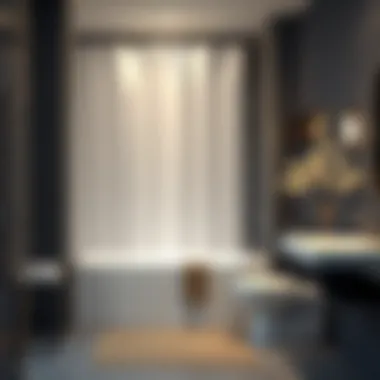
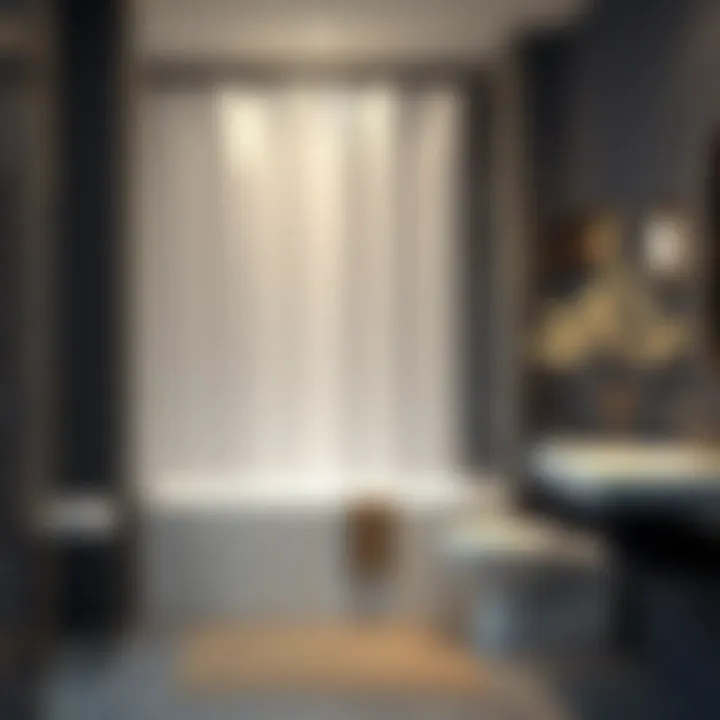
Intro
The bathroom may not often be the focal point of interior design, but it certainly holds its ground in functionality and aesthetics. When discussing bathroom covers, we aren't simply talking about the items that mask unsightly elements. Rather, we delve into a broader perspective that involves style, utility, and hygiene. Whether it’s the shower curtain that defines the ambiance or the toilet lid that adds a touch of color, each element plays a role in transforming a mundane space into a stylish retreat. This guide aims to clarify various types of bathroom covers, presenting insights on how they contribute to both form and function, something crucial for homeowners, designers, and DIY enthusiasts.
Furniture Trends and Styles
In the context of bathroom covers, let’s explore current trends and popular styles that can shape the look of your space.
Current Trends in Bathroom Design
Bathrooms today are trending more towards personalization. The use of unique shower curtains, artistically designed toilet lids, and various styles of floor mats has become a means to express one’s personality.
Some popular trends include:
- Eco-Friendly Materials: Many homeowners are now opting for organic cotton shower curtains or bamboo mats, aiding in both sustainability and aesthetics.
- Bold Prints: From geometric patterns to vibrant florals, bold prints are making a statement. Adding that pop of color can elevate a space.
- Minimalist Designs: A sleek, minimalist look often features neutral shades and refined materials, catering to a clean and organized appearance.
Popular Styles and Their Characteristics
When looking at bathroom covers, understanding the various styles helps in making informed choices. Here are a few:
- Contemporary: This style embraces clean lines and a restrained color palette.
- Bohemian: If you’re after something a bit more free-spirited, consider an eclectic mix of patterns and textures.
- Classic: Timeless designs often involve whites and creams, coupled with elegant patterns.
When selecting styles, consider the overall theme of your bathroom. A Victorian theme, for instance, may clash with a modern cover, while something rustic may complement a wooden bath décor seamlessly.
"The right bathroom cover not only serves a purpose but also enhances the ambiance and reflects your personal style."
Buying and Maintenance Guides
After understanding trends and styles, it’s crucial to consider how to choose and maintain these covers effectively.
Essential Tips for Purchasing Bathroom Covers
- Material Matters: Know the differences between vinyl, fabric, and natural materials. Each has its specific care requirements and longevity.
- Functionality: Ensure that whatever cover you choose doesn’t just look good but also contributes to hygiene, for example, a washable shower curtain.
- Size Considerations: Measure twice, buy once. A poorly fitting mat or shower curtain can ruin the whole look.
Maintenance and Care for Different Bathroom Cover Materials
- Fabric Covers: Regular washing—ideally every few weeks—helps keep mildew at bay.
- Vinyl Covers: A quick wipe with a damp cloth should suffice, but be cautious as these can tear if not treated kindly.
- Mats: Depending on the material, some can be machine washed, while others may require hand cleaning.
By following good buying and maintenance practices, one can not only enhance bathroom aesthetics but also improve the overall hygiene and functionality of the space.
As we continue to discover the multifaceted aspects of bathroom covers, each choice made contributes significantly to creating a relaxing and inviting sanctuary.
Understanding Bathroom Covers
In the realm of interior design, particularly in spaces often overlooked like bathrooms, the nuanced role of bathroom covers deserves a moment in the spotlight. These seemingly mundane elements—whether toilet lids, shower curtains, or floor mats—serve greater purposes than merely keeping things tidy and private. Understanding bathroom covers is paramount for several reasons: their impact on aesthetics, hygiene, comfort, and even safety contribute significantly to the overall bathroom experience.
Bathroom covers create a balance between functionality and style. Choosing the right cover not only elevates visual appeal but also addresses crucial considerations such as cleanliness and durability. Homeowners and designers alike should grasp the importance of these covers as they aren’t just decorative pieces; they play a pivotal role in shaping the environment where daily routines unfold.
In light of increasingly busy lifestyles, the bathroom has transitioned from a simple utility space to a personal retreat. Here, bathroom covers can either enhance or detract from that ambiance. They have the capability to reflect personal taste, coupled with modern trends, making the act of choosing covers a blend of personal expression and thoughtful practicality. The modern consumer is now well-informed and seeks products that marry aesthetics with sustainability and longevity. Let's dive deeper into the specifics of bathroom covers, starting with definitions and the intrinsic purposes they serve.
Definition and Purpose
Bathroom covers, by definition, encompass items that shield various elements of the bathroom from dust, moisture, and even embarrassing mishaps. They include toilet seat covers, shower curtains, and floor mats, each tailored to fulfill specific roles. However, their purpose stretches beyond mere protection; they contribute significantly to hygiene, warmth for bare feet and stylistic expression within a traditionally sterile setting.
For instance, toilet covers not only serve the basic function of covering the toilet but also can prevent germs from spewing during flushes. Shower curtains define bathing areas, creating boundaries that not only keep water contained but also set the mood through patterns and colors. Floor mats add comfort underfoot and can prevent slipping, creating a safer space. Thus, understanding bathroom covers means appreciating their multifaceted functionality.
Historical Perspective
Historically, the concept of bathroom covers has evolved significantly. In the early days, bathrooms were purely utilitarian spaces with minimal attention given to aesthetics. The introduction of basic covers can be traced back to privacy concerns—especially in shared spaces. Over time, as access to plumbing improved and hygiene awareness became more prevalent, the sophistication of bathroom covers blossomed.
In the 20th century, the rise of interior design as a formal practice ushered in a new era for bathroom covers. The post-war boom saw the emergence of synthetic materials, revolutionizing options available to the average consumer. Meanwhile, the 1980s and 90s highlighted vibrant colors and playful patterns, embracing an era of self-expression. Today, there is a notable return to sustainability, with emphasis on natural materials and eco-friendly production processes, showcasing a growing awareness of environmental impact.
Understanding the historical journey of bathroom covers underscores their significance, transforming them from mere functional items to essential components of modern bathrooms that reflect both individual style and broader cultural trends.
“The bathroom is a sanctuary for personal growth; covers are the walls that provide both privacy and opportunity.”
This exploration leads us seamlessly into discussing the various types of bathroom covers, each unique in its offering and appeal.
Types of Bathroom Covers
When it comes to creating a comfortable and stylish bathroom, the choice of covers plays a critical role. Bathroom covers, including toilet lids, shower curtains, and bathroom mats, serve not just functional purposes but also enhance the overall aesthetic. Depending on their design and materials, these elements can contribute to a bathroom's ambiance, making it a more inviting space. In this section, we will dive into various types of bathroom covers, examining their specific advantages, unique features, and considerations for usage.
Toilet Covers
Toilet covers are essential accessories that provide both comfort and hygiene in bathroom settings. They come in different styles and materials, with some major distinctions worth discussing.
Hard Vs. Soft Covers
When comparing hard and soft toilet covers, it's essential to recognize their defining characteristics. Hard toilet covers, usually made of rigid materials such as plastic or wood, offer significant durability and ease of cleaning. This is a good choice for households with children or frequent guests, where wear and tear can happen quickly.
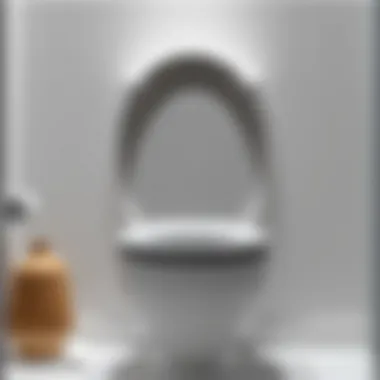
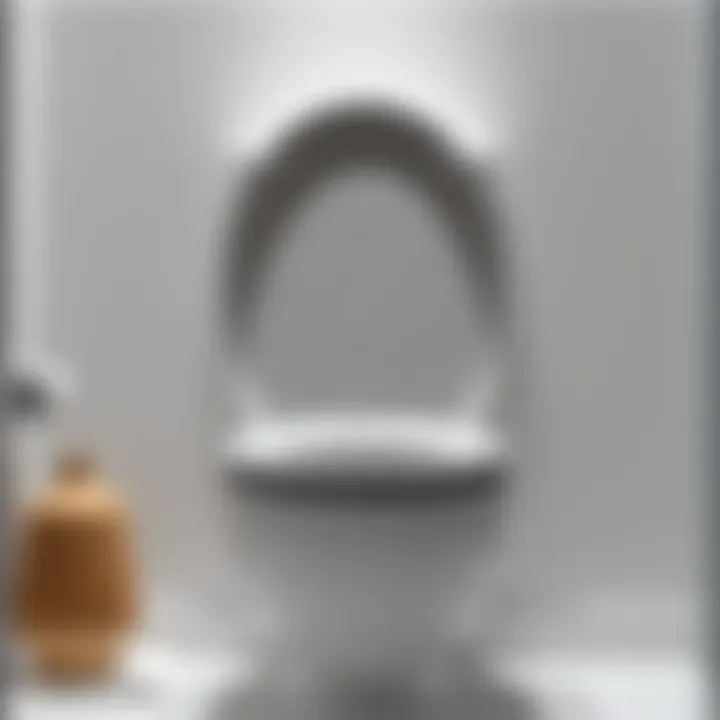
On the flip side, soft covers, usually padded and upholstered, present a different appeal. They provide a more cushioned seating experience, which many find cozy. However, they may require more upkeep since they can attract dirt and moisture more easily than their hard counterparts.
Tossing a hard cover into the mix can be beneficial due to its longevity and simple maintenance, while soft covers might win you over with comfort. Ultimately, the choice between hard and soft is about weighing the trade-offs between durability and comfort in your own context.
Impact on Hygiene
The impact on hygiene when selecting toilet covers cannot be understated. Hard covers typically provide a more sanitary solution, as they can be quickly wiped down with disinfectants, preventing bacteria build-up. Soft covers, by contrast, can be more challenging to maintain in terms of cleanliness. Often made from fabric, they can harbor germs if not washed regularly.
This characteristic makes it critical to gauge how hygiene factors into your lifestyle. If you often entertain guests or if your bathroom sees heavy use, you'll likely benefit from the more straightforward maintenance of hard covers. On the other hand, if aesthetics and comfort are your main interests, a soft cover can still serve aesthetic goals with additional effort to maintain cleanliness.
Shower Curtains
Shower curtains are another critical bathroom cover, adding flair while also serving a very practical purpose. Their material and texture significantly influence both functionality and design.
Materials and Textures
Shower curtains come in a variety of materials like vinyl, fabric, and polyester. Vinyl curtains are least expensive and offer strong water resistance. However, they can sometimes lack the visual appeal that other materials provide. On the other hand, fabric curtains, whether made from cotton or another textile, boast a wider array of textures and colors, elevating the bathroom's overall look.
The choice of texture also matters. A smooth texture might appeal to minimalists, while textured options can offer additional character and depth. Ultimately, the material and texture you choose can dramatically affect the atmosphere of your bathroom while also contributing to moisture control.
Patterns and Colors
The patterns and colors of shower curtains can decisively shift the mood of a bathroom. Bright colors or fun patterns can energize the space, while muted tones may create a calm and serene atmosphere. Depending on your personal style or the overall theme you are aiming for, you’ll want to select patterns that either complement or contrast the existing decor.
Moreover, shower curtains offer a relatively inexpensive way to refresh a bathroom’s look without a complete renovation. Just remember that darker patterns might hide stains but can also absorb heat and lead to quicker fade from sunlight. Thus, balance is key when choosing both color and design.
Bathroom Mats
Bathroom mats offer functionality and comfort, serving as a safety barrier between your feet and the cold tile floors while also preventing slips and falls.
Types of Mats
Bathroom mats vary widely from plush rugs to quick-dry options. Plush mats offer cushiony luxury underfoot but can retain moisture longer, leading to potential mildew. Quick-dry mats, made from materials engineered to resist moisture, dry faster but may sacrifice some of the comfort found in thicker styles. Each type possesses strengths that can align with your needs, depending on factors like bathroom design and personal preferences.
Safety Considerations
Safety is paramount when selecting bathroom mats. Non-slip mats can significantly reduce the risk of falls, especially in spaces that are frequently wet. It's important to ensure that you choose mats with a sturdy backing that stays put when stepped on.
Moreover, consider how the mat's maintenance can impact safety; a mat that can be machine washed or dried easily can prevent the build-up of bacteria and mildew, ensuring a cleaner bathroom environment.
Each choice of bathroom cover carries weight in not only aesthetics but also functionality and safety. By understanding these factors, homeowners and decorators can make informed decisions, elevating the bathrooms from purely functional spaces into welcoming environments.
Materials Used in Bathroom Covers
Bathroom covers come in a variety of materials, each with unique qualities that influence not just their function, but also the overall aesthetic of your bathroom. The choice of material can significantly affect durability, maintenance requirements, and your space's visual appeal. Understanding these materials allows homeowners and designers to make informed decisions that enhance both practicality and style.
Fabric Options
Water-Resistant Fabrics
When it comes to bathroom covers, water-resistant fabrics stand out as a smart choice. These materials repel moisture, preventing mold and mildew, which is a common concern in damp environments. The key characteristic of water-resistant fabrics is their ability to maintain functionality without compromising comfort. They often come in various textures and weights, making them versatile for different applications, whether it's a shower curtain or a toilet lid cover.
One unique feature that enhances their popularity is the ease of cleaning. Most water-resistant fabrics can be wiped down or thrown in the washing machine, keeping them looking fresh. However, while they resist water, it’s important to note that they may not be entirely waterproof, which can lead to longer drying times after heavy exposure to water.
Durability vs. Comfort
A constant tug-of-war exists between durability and comfort. This aspect becomes crucial, especially for families with kids or in high-traffic bathrooms. A sturdy material like thick cotton may last longer, but it can lack the softness that some users desire. This contradiction is why many opt for blends that offer a satisfactory balance.
The unique feature of choosing the right mix plays a significant role. If you prioritize durability, you're likely to select fabrics that might feel coarse against the skin. Conversely, opting for plush materials can lead to wear and tear much faster. Thus, understanding your specific needs and usage patterns is vital.
Wood and Bamboo
Natural Aesthetics
Natural materials, particularly wood and bamboo, bring a breeze of the outdoors into your bathroom. Their aesthetic appeal often aligns perfectly with eco-friendly designs, offering a rustic charm that synthetic materials can’t quite replicate. The unique characteristic of wood and bamboo is that they can add a warm, inviting look to your space.
However, while their beauty is often undeniable, they do require careful consideration. For instance, certain wood types can warp when exposed to constant moisture if not treated properly. Therefore, proper sealing or choosing bamboo, which is more resistant to moisture, becomes essential.
Maintenance Challenges
While wood and bamboo might appeal to the eye, they present maintenance challenges. Ensuring they remain in good condition requires regular maintenance like sealing and occasional varnishing. This level of care might deter some homeowners, especially those who prefer low-maintenance options.
A unique feature of these materials is their susceptibility to scratches and dents, which can detract from their appearance. While they can last long with the right upkeep, neglect can turn beautiful covers into shabby ones much faster than anticipated.
Synthetic Materials
Advantages Over Natural Materials
Synthetic materials have gained traction in the world of bathroom covers, and for good reason. They often boast numerous advantages over natural materials, including their resistance to stains and moisture. The most notable characteristic is their lower maintenance requirements. Unlike wood or cotton, synthetic options often make cleaning a breeze. Just a quick wipe down with a damp cloth usually does the trick.
The unique feature of synthetic materials is their ability to mimic the look of their natural counterparts without the drawbacks. For example, a synthetic wood-look vinyl cover can offer all the beauty of wood without the need for sealing or varnishing. However, the downside may include a lack of breathability, which can be an issue in humid bathrooms.
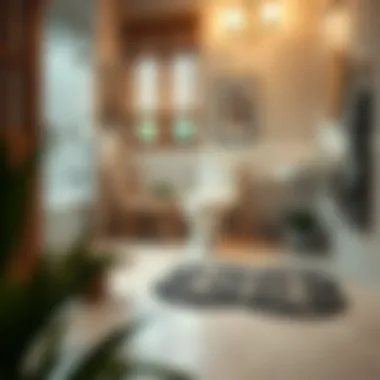

Environmental Considerations
Environmental considerations regarding synthetic materials often stir debate. Although they provide practical benefits, concerns about sustainability come into play. Many synthetic products are derived from non-renewable resources or carry a significant carbon footprint in their production process.
A unique feature of some newer synthetic materials is their eco-friendly counterparts made from recycled resources. These options can reduce environmental impact while still maintaining functionality and style. However, the trade-off may be in cost, often priced higher than conventional synthetic materials.
Ultimately, weighing the pros and cons of materials used in bathroom covers leads to better decisions that can enhance your bathroom aesthetically and functionally.
Design Considerations
When it comes to the layout and aesthetic of a bathroom, design considerations are paramount. From the moment you step into the space, it's clear that everything from color to style plays a critical role in how we perceive functionality and comfort. Bathroom covers, which often take a back seat in discussions about home decor, can either uplift or detract from the overall ambiance. Choosing appropriate designs not only affects aesthetics but also bolsters the bathroom's functionality and user experience.
Color Schemes
Trendy Palettes
The use of trendy palettes in bathroom covers is increasingly relevant in today's design landscape. These palettes offer a fresh and contemporary vibe that can breathe new life into an otherwise mundane space. Think muted pastel colors or bolder jewel tones. Each trend has its own set of advantages. For example, pastel colors can create a serene, spa-like atmosphere, while bold hues may inject energy and vibrancy into the room.
A key characteristic of trendy palettes is their adaptability. Homeowners can easily mix and match tones to create unique combinations that resonate with their individual style. However, one must tread carefully, as a hasty choice could lead to a design clash. Thus, balancing trendy options with classic elements is crucial for enduring appeal.
"In design, your palette should reflect you, yet not overshadow the space."
Psychological Effects of Colors
The psychological effects of colors are essential when designing a bathroom environment. Colors have the power to influence mood and behavior, and understanding this can enhance your design choices tremendously. For instance, the soothing effect of blues and greens is well-documented, promoting relaxation. In contrast, yellows can evoke warmth and cheerfulness but should be used sparingly to avoid overwhelming the senses.
This characteristic of colors might be particularly beneficial in a space meant for rejuvenation. However, overuse of any one color can create visual fatigue and detract from the relaxing qualities we often seek in bathrooms. Therefore, blending colors that complement each other while considering their psychological impacts can create a balanced and inviting atmosphere.
Integration with Bathroom Decor
Coordinating Styles
Coordinating styles in bathroom covers are extremely important for achieving a cohesive look. This means that every element — from shower curtains to toilet covers — should visibly connect with one another. For example, using earthy textures in mats and wooden elements can bring about an organic feel, while metallic accents may offer a modern flair.
The primary benefit of this approach is that it unifies the space, creating an inviting ambience. However, the challenge lies in finding that sweet spot where the styles complement each other rather than compete. Too much variation in styles can result in a chaotic feel that detracts from the overall design.
Creating Visual Harmony
The notion of visual harmony revolves around the relationship of design elements within a bathroom. It’s often said that a well-designed space is one where every aspect feels intentional. Creating visual harmony through specific patterns and colors leads to a soothing experience.
The aim is to achieve a seamless flow from one element to another, with bathroom covers acting as a centerpiece that ties everything together. While achieving this harmony can be intuitive for some, it may also require careful planning, as mismatched elements can easily fracture the intended aesthetic.
Maintenance and Care
Maintaining and caring for bathroom covers is essential for keeping the space not only functional but also visually appealing. Over time, wear and tear can lead to unsightly stains, odors, and a general decline in aesthetics. This section will detail effective maintenance practices, focusing on cleaning techniques and longevity tips that can help extend the life of bathroom covers.
Cleaning Techniques
Recommended Products
When it comes to cleaning bathroom covers, having the right products makes all the difference. All-purpose cleaners are often favored due to their versatility. They can tackle a range of surfaces, from fabric shower curtains to plastic toilet covers. Look for cleaners that include antimicrobial properties, as these can help combat bacteria and mold growth.
Another popular choice includes enzyme cleaners. These products are particularly effective in breaking down organic stains, like mildew or soap scum, and are safe for most materials. Their unique feature is that they continue to work even after the initial application, slowly breaking down stains over time, which ensures a cleaner surface.
However, one must exercise caution. Some products might be too harsh and affect the color or texture of your covers. Always test a small, inconspicuous area first. The right cleaning products thus balance effectiveness and safety, ensuring that your bathroom remains a hygienic place.
Sustainable Cleaning Options
In recent years, many people have turned to sustainable cleaning options as a responsible choice for both health and environmental reasons. These products emphasize natural ingredients, avoiding harsh chemicals that can harm the environment. Many eco-friendly cleaners derive their cleaning power from ingredients like vinegar or baking soda, both of which can be surprisingly effective at removing grime.
The appeal of sustainable cleaning lies in its safety; they often pose less risk to pets and young children. Furthermore, you can create DIY solutions at home, which can save money and cut down on plastic waste. A unique aspect of these options is that they demonstrate how effective simplicity can be, allowing homeowners to maintain cleanliness without relying on synthetic substances.
However, keep in mind that while sustainable options are beneficial, they may require a bit more effort and frequent application compared to conventional cleaners. Balancing efficacy with environmental responsibility is a cornerstone of modern cleaning practices.
Longevity Tips
Storing Off-Season Covers
When it comes to extending the life of bathroom covers, proper storage is often overlooked. If you're using seasonal covers, like holiday-themed items, store them carefully when not in use. Using airtight storage containers can protect them from dust, moisture, and pests that could otherwise lead to damage.
A significant advantage of good storage practices is that they help preserve colors and materials, meaning you won't have to replace covers as frequently. Keeping them stored in a controlled environment, away from direct sunlight, can prevent fading and deterioration. Thoughtful storage indeed contributes to making the most of your investment in bathroom decor.
Regular Inspections and Repairs
Regular inspections of bathroom covers can be a game-changer. Don't wait until a cover is falling apart to take action. Making it a habit to inspect for wear and damage can prevent bigger issues in the long run. This includes looking for frayed edges on mats or tearing on shower curtains. Addressing these issues promptly can save your wallet from costly replacements down the line.
Additionally, many covers can be repaired. Whether it’s sewing a small tear or re-attaching a loose button, minor repairs can extend the life of your items significantly. The exciting part is that it encourages a more mindful approach to home management, allowing you to take pride in preserving your belongings while also being economically astute.
Investing a little time in maintenance can go a long way in enhancing the longevity of bathroom covers.
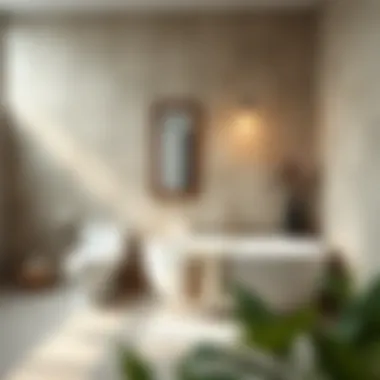
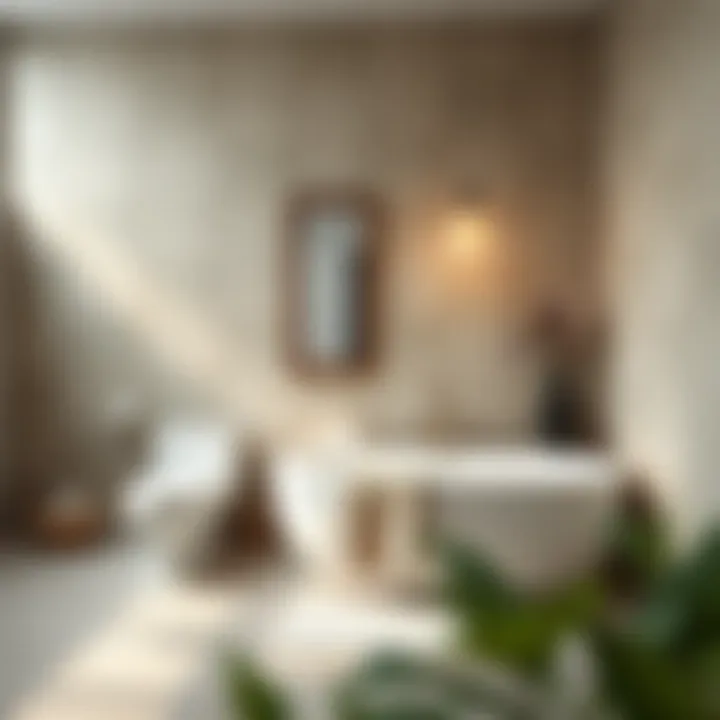
Trends in Bathroom Covers
As the cultural tide shifts towards more sustainable and design-conscious living, the realm of bathroom covers is no exception to these stellar trends. Homeowners, designers, and DIY enthusiasts are increasingly seeking bathroom covers that not only serve practical functions but also resonate with their values and aesthetic sensibilities. This section will traverse the most significant trends influencing bathroom covers today, touching particularly on materials and minimalist design—a duo that seems to encapsulate a broader movement in home decor.
Sustainability in Materials
In recent years, sustainability has grown from a buzzword into a pivotal concern in home decor. Bathroom covers are no longer solely about functionality; they also encompass a commitment to the environment. The demand for eco-friendly materials in bathroom covers is skyrocketing, as consumers become more aware of their carbon footprint.
Popular sustainable materials include:
- Recycled fabrics: Fabrics made from recycled plastic, such as rPET (recycled polyethylene terephthalate), are being used in shower curtains and mats, turning waste into a functional product.
- Natural fibers: Organic cotton, hemp, and bamboo are gaining ground. They offer a soft touch, durability, and again, less impact on the environment compared to synthetic counterparts.
- Biodegradable options: Products like certain types of rubber and sustainably sourced wood integrate seamlessly into the bathroom space without the persistent footprint of plastics.
Organizations like Earth911 and sites such as GreenBuildingAdvisor provide extensive resources to help homeowners navigate sustainable options when outfitting their bathrooms. The push towards sustainable materials does not merely reflect a concern for the planet but also embodies a shift in consumer preferences where performance aligns with ethics.
Influence of Minimalism
Minimalism is a design philosophy that champions simplicity and the elimination of excess. In the bathroom, this trend manifests in several ways—particularly through the selection of covers.
When choosing bathroom covers with a minimalist approach, consider these core principles:
- Neutral Colors: Soft whites, muted grays, and earth tones dominate these spaces, affirming calm and focus, while vibrant colors take a backseat.
- Simple Designs: Covers without elaborate patterns or excessive detailing create a serene atmosphere. Think plain shower curtains and straightforward mats that do not distract from the overall ambiance.
- Functional Forms: Minimalism emphasizes utility, so selecting covers that are both practical and aesthetically pleasing without the clutter of unnecessary features is key. For instance, simple round toilet covers can reflect a streamlined beauty without sacrificing function.
"In design, less is often more. A minimalist approach to bathroom covers can significantly enhance both the visual appeal and functionality of the space."
Websites like Architectural Digest and Dwell often highlight minimalist design trends, showcasing how to incorporate such aesthetics effectively into bedroom and bathroom designs.
Epilogue
The trends shaping bathroom covers today are intricate, intertwining sustainability with minimalism. These shifts reflect a broader cultural movement toward conscientious living while enhancing the personal sanctuary that is the bathroom. The conversation about bathroom covers is no longer confined to what looks good; it now includes what feels responsible and right for the environment. By embracing these trends, homeowners can create spaces that are not only visually stunning but also echo a commitment to sustainability and simplicity.
Choosing the Right Bathroom Cover
Selecting bathroom covers truly means more than just picking something nice off the shelf; it involves considering the unique needs and circumstances of your space. This decision can influence not only the visual appeal of the bathroom but also its hygiene, functionality, and overall comfort. Engaging in thoughtful choices here can elevate the experience of one of the most frequently used spaces in any home.
Assessing Personal Needs
Size and Space Considerations
When it comes to size and space, every bathroom is a story of constraints and opportunities. First and foremost, one must accurately measure the available area where a cover will sit. This allows a decorative piece to fit like a glove without overcrowding the space.
The key characteristic of size consideration is the hint of proportion. If your bathroom has a small footprint, opting for lighter colors or airy designs can create a sense of openness. It’s this interplay of dimensions that offers advantages—setting a tone that aligns with the space. Though on the flip side, larger bathrooms might embrace bolder patterns, which can sometimes overwhelm the senses if not balanced correctly. Furthermore, an oversized cover can become a hassle during cleaning.
Ultimately, ensuring that bathroom covers harmonize with your bathroom's dimensions can prevent aesthetic blunders that might lead to dissatisfaction with the space.
Usage Patterns
Understanding usage patterns can be enlightening. Ask yourself, "How do I use my bathroom?" This question brings clarity to the choice of covers. For instance, a family bathroom usually sees more foot traffic and wear and tear compared to a guest bathroom.
One interesting aspect is the dual function of some bathroom covers—they're not just decorative but serve a practical role too. A good-quality shower curtain, for instance, can hide the chaos of bath time while adding a splash of color. The choice of patterns or colors based on usage can enhance the overall emotional and functional experience of your space. However, opting for detailed patterns might require more frequent washing, which speaks to a downside that needs consideration.
Consider this: a single person might have different needs compared to a bustling family. Thus, matching the cover's utility to the frequency of use helps in making decisions that are both aesthetically pleasing and practical.
Budgeting and Value
Delving into budgeting paints a clearer financial picture when acquiring new bathroom covers. It’s essential to distinguish between cost-effective choices that don’t skimp on style and those that may look appealing initially but lead to long-term expenses due to durability issues.
Cost-Effective Choices
Cost-effective choices should be seen in the light of balance. You might be tempted to go for the cheapest option, yet this can often lead to regret down the line if the quality is subpar. Selecting covers that maintain a level of durability while keeping an eye on budget speaks volumes about smart shopping.
The prime characteristic here is longevity at an affordable price. For example, opting for a well-reviewed shower curtain made from quality vinyl rather than a cheaper variant can save you more sweat and tears in the long run. Though these bargains have their charm, their shorter lifespan might eat into savings intended for other aspects of home decor.
Investing in Quality
When you're looking at investing in quality, remember that some decisions carry weight that far surpasses the immediate cost. Quality bathroom covers withstand the frenzy of daily life far better than their cheaper counterparts. They can be both astatically pleasing and incredibly functional.
The standout characteristic of investing in quality is resilience. Take a high-quality bamboo mat, for instance. While it may come with a heftier price tag, its organic texture and longer lifespan offer both durability and style. What’s more, you’re likely to evade the constant cycle of replacements that cheaper options often bring. Indeed, spending a little now could save a lot later.
Culmination
In summing up the intricate concepts surrounding bathroom covers, it becomes clear that these elements are not merely functional but also pivotal in crafting the overall ambiance of the bathroom space. From the toilet lids to the used shower curtains and floor mats, each aspect contributes uniquely to both hygiene and aesthetics. This article underscores the importance of taking an informed approach to selecting bathroom covers, emphasizing the variety of choices available and how one's personal preferences align with trends in interior design.
While functionality remains key, the combination of materials, colors, and patterns can breathe life into a bathroom. For homeowners and designers alike, understanding these functional elements coupled with their stylistic impact leads to more satisfying and harmonious bathroom environments.
Bathroom covers represent a thoughtful intersection of necessity and artistry, making careful consideration paramount when sourcing these items. The takeaway is that with the right approach, not only can one enhance hygiene but also elevate the decor to a place of beauty and comfort.
"The bathroom is a private haven, deserving of a tailored touch that resonates with one’s style."
Recap of Key Points
- Bathroom covers play an essential role in functionality, hygiene, and aesthetics.
- Different types of covers address unique needs, including toilet seats, shower curtains, and mats.
- A variety of materials such as fabrics, wood, bamboo, and synthetics cater to both comfort and sustainability.
- Design choices encompass color schemes and integration with overall bathroom decor.
- Regular maintenance and care can prolong the life of these covers, ensuring their usefulness and appearance.
- Trends, such as minimalism and sustainability, influence contemporary choices in bathroom cover selections.
Final Thoughts on Bathroom Aesthetics
As we step away from this exploration, consider the bathroom not just as a functional space but as an extension of personal expression. The right bathroom covers can transform a drab environment into a relaxing retreat, echoing one’s taste and lifestyle.
Homeowners, designers, and DIY enthusiasts should feel encouraged to express their style through thoughtful selections of bathroom covers, always considering that this small space can yield significant impact.







